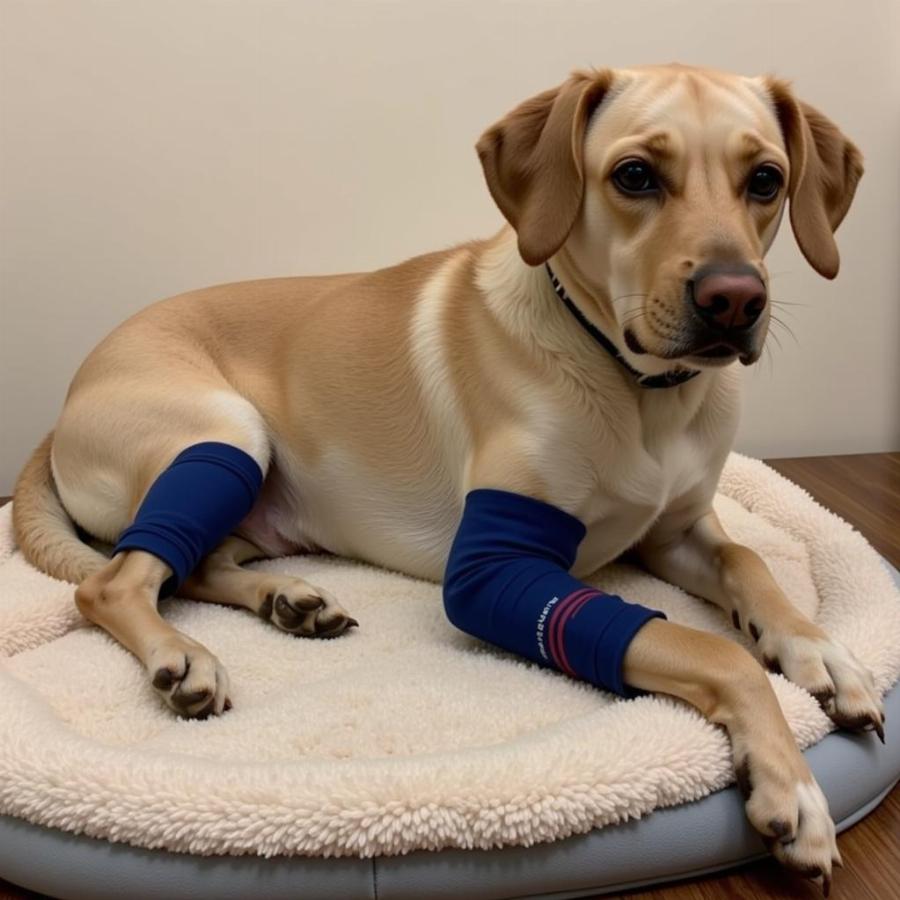Dog TTA surgery, or Tibial Tuberosity Advancement, is a sophisticated procedure designed to stabilize the knee joint in dogs suffering from a ruptured cranial cruciate ligament (CCL). This injury, similar to an ACL tear in humans, can be debilitating for our canine companions, causing pain, lameness, and decreased mobility. Understanding TTA surgery is crucial for any dog owner facing this challenging diagnosis.
Understanding the Need for Dog TTA Surgery
Why would a dog need TTA surgery? The cranial cruciate ligament (CCL) is a vital stabilizer in a dog’s knee, preventing the tibia from sliding forward in relation to the femur. When this ligament ruptures, the knee joint becomes unstable, leading to pain and difficulty walking. TTA surgery offers a dynamic solution by altering the biomechanics of the knee, eliminating the need for the CCL altogether. This is different from other surgical options, which attempt to reconstruct the ligament.
How Does Dog TTA Surgery Work?
TTA surgery involves cutting the tibia and advancing the tibial tuberosity forward. A bone graft or implant is then placed in the gap created by the advancement, stabilizing the tibia and eliminating the abnormal forward movement. This alters the forces acting on the knee, effectively neutralizing the need for the CCL. This procedure allows for faster recovery and earlier return to weight-bearing compared to some other surgical options.
Preparing Your Dog for TTA Surgery
Pre-operative care is essential for a successful outcome. Your veterinarian will likely recommend blood work and other diagnostic tests to ensure your dog is healthy enough for surgery. You’ll also need to restrict your dog’s activity in the weeks leading up to the procedure to minimize inflammation and pain.
Post-Operative Care and Recovery for TTA Surgery in Dogs
Post-operative care is just as important as the surgery itself. Your dog will need strict rest and limited activity for several weeks. Pain management is crucial, and your veterinarian will prescribe appropriate medications. Physical therapy is often recommended to help restore strength and range of motion in the affected leg. Regular check-ups with your veterinarian are essential to monitor healing and address any complications.
Is TTA Surgery the Right Choice for My Dog?
Choosing the right surgical option for your dog depends on various factors, including breed, size, age, activity level, and the severity of the CCL tear. Your veterinarian will discuss the pros and cons of TTA surgery compared to other options like TPLO (Tibial Plateau Leveling Osteotomy) and extracapsular repair.
 Dog TTA Surgery Aftercare
Dog TTA Surgery Aftercare
What are the potential complications of TTA surgery in dogs?
While generally safe and effective, TTA surgery, like any surgical procedure, carries potential risks such as infection, implant failure, and tibial fracture. Discussing these risks with your veterinarian will help you make an informed decision.
What is the typical recovery time for TTA surgery in dogs?
Most dogs can return to normal activity within 6-8 months after TTA surgery, though individual recovery times may vary.
How much does TTA surgery for dogs cost?
The cost of TTA surgery can vary depending on location and veterinary practice, but it typically ranges from $3,000 to $5,000.
Conclusion
Dog TTA surgery offers a viable solution for dogs suffering from CCL ruptures. Understanding the procedure, pre and post-operative care, and potential risks empowers you to make the best decision for your beloved companion. Remember to consult with your veterinarian to determine if dog TTA surgery is the right option for your furry friend.
FAQ
- Is TTA surgery painful for dogs? Pain management is a priority throughout the recovery process, and your veterinarian will prescribe appropriate medications to keep your dog comfortable.
- Can my dog run and play after TTA surgery? Yes, but only after a period of controlled recovery and rehabilitation.
- What are the alternatives to TTA surgery? TPLO and extracapsular repair are alternative surgical options for CCL tears.
- How can I help my dog during recovery? Providing a quiet, comfortable environment, adhering to the prescribed activity restrictions, and attending physical therapy sessions are crucial.
- Are there any long-term effects of TTA surgery? Most dogs regain full function after TTA surgery and experience no long-term complications.
Beaut Dogs is your trusted source for comprehensive information on dog care, providing expert advice and resources to help you navigate the world of dog ownership. For personalized guidance on TTA surgery or any other canine health concern, contact us via Email: [email protected]. We’re here to support you and your furry friend every step of the way. Beaut Dogs is committed to providing you with the most up-to-date information and resources for all your dog care needs. Visit us at https://beautdogs.com to learn more.